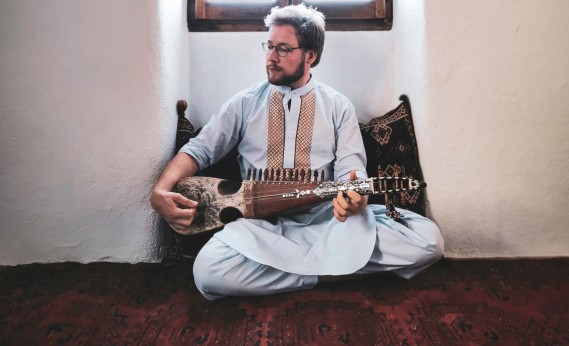adem
d'ethnomusicologie
Rubab and music from Afghanistan
Mathieu Clavel
Asia | Instruments & repertories

Afghanistan is a land of mystery, set at the crossroads of Indian, Persian and Turkic cultures, the cradle of the greatest mystical poets of the East. Of Pashtun origin, the rubab (or rabab, robab) with its unique sounds is an instrument of choice in this area to accompany Sufi poems and popular songs. It also illustrates itself in a solo repertoire from the court dance.
Its training is based on the traditional repertoire of Kabul and the basics of Hindustani music (râga, tâla, saregam), with particular attention paid to the rhythmic work of the right hand, whose technique is essential to make the "lion of instruments" sing. The transmission is oral and does not make use of scores: reading is secondary, listening fundamental.
Once a solid technical foundation has been acquired, it is possible to continue the practice by exploring the vast ocean of North Indian râga, drawing from the compositions for sarod of the gharana, tradition of Gwalior, as well as from the different Afghan styles and the various neighboring repertoires that appreciate the rubab (Baluchistan, Kashmir, Badakhshan).
"Today as every day, we are miserable. Close the way to vain thoughts, and play the rubab. As if a hundred times you had prostrated yourself, the beauty of the Beloved will be pleasing to you."
Jalaleddin Rumi Balkhi
Bio
Passionate about the traditional music of the Silk Roads, Mathieu Clavel is a disciple of the Afghan master Ustad Daud Khan Sadozai, heir of Ustad Mohammad Omar, the "Sultan of the Rubab", and of Ustad Amjad Ali Khan, one of the most eminent musicians of North India today.
With the "ejaza" (permission and blessing) of his master, he began to pass on the knowledge he had received in early 2021, thus continuing the chain of tradition. At the same time, he strives to contribute to the preservation of the Afghan musical heritage.
PLACE : Ateliers d'ethnomusicologie - 10, rue Montbrillant - 1201 Genève
TIMETABLE :
Les vendredis de 17h à 18h
FEES :
Individual lesson : 60.- CHF
CONTACT :
Email: clavel.mathieu@gmail.com
Discover other classes
Afro-fusion dances - adults
NEW COURSE FOR ADULTES
Dominique Rey
This class will explore the language of contemporary African dance, its energy and rhythms.
Greek Singing
Lessons by zoom or whereby on request - Infos below
Anna Koti
These classes are aimed at those who wish to develop their vocal ability and discover the performance of Greek song and its diverse styles: traditional, rebetiko, popluar and contemporary.
Persian Dance
Sepideh Nayemi
The aims of this course include discovering and developing natural grace, learning to express yourself freely in movement and enjoying dancing to the subtle rhythms and melodies of traditional Persian music.
Corsican Polyphony
Tristan Morelli
The oral tradition of Corsican vocal polyphony is wide open to expression through its various forms. The rawness and vitality of these songs take you on a journey to the depths of an often underappreciated Corsica, which is as mountainous as it is welcoming, as astonishing as it is generous.